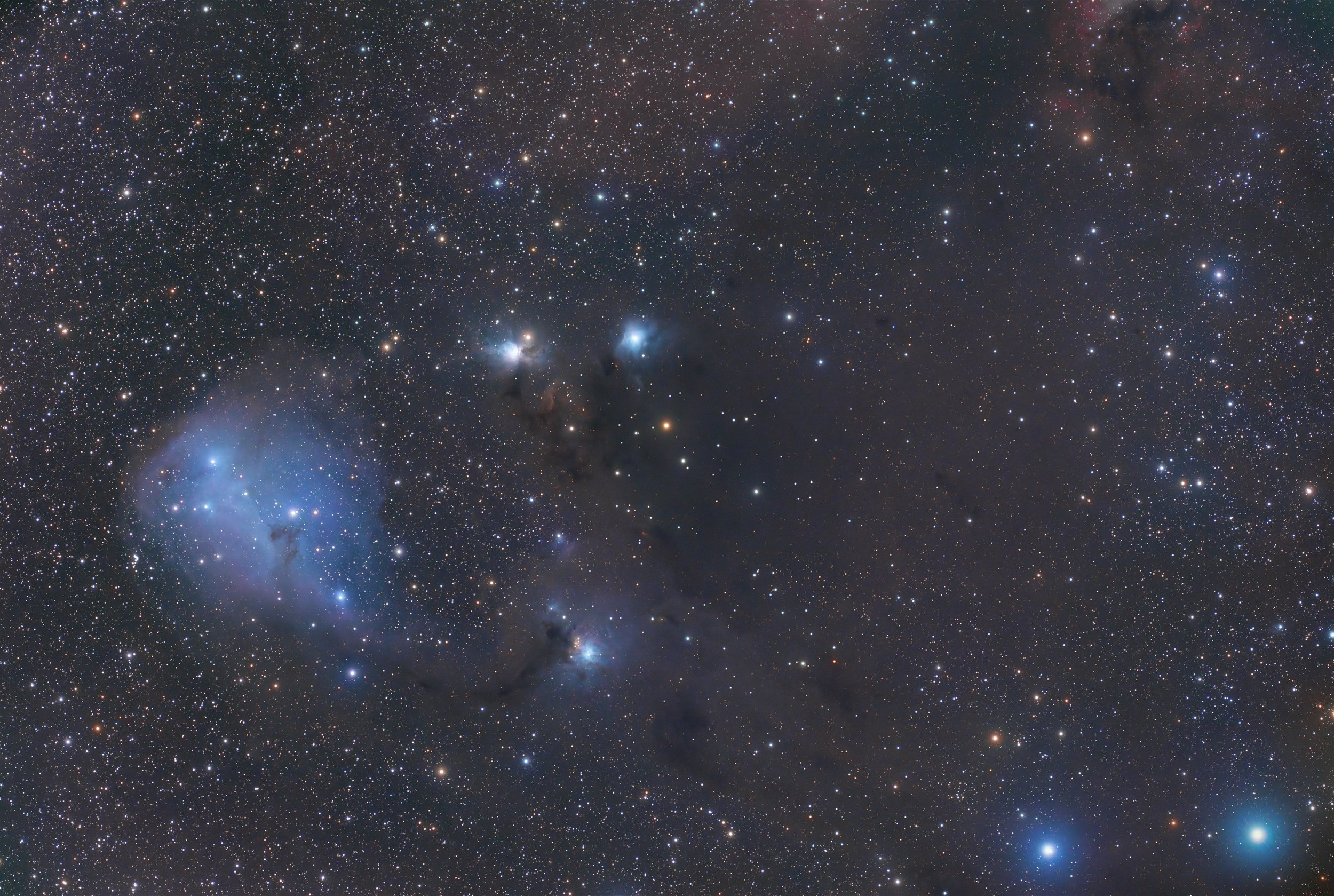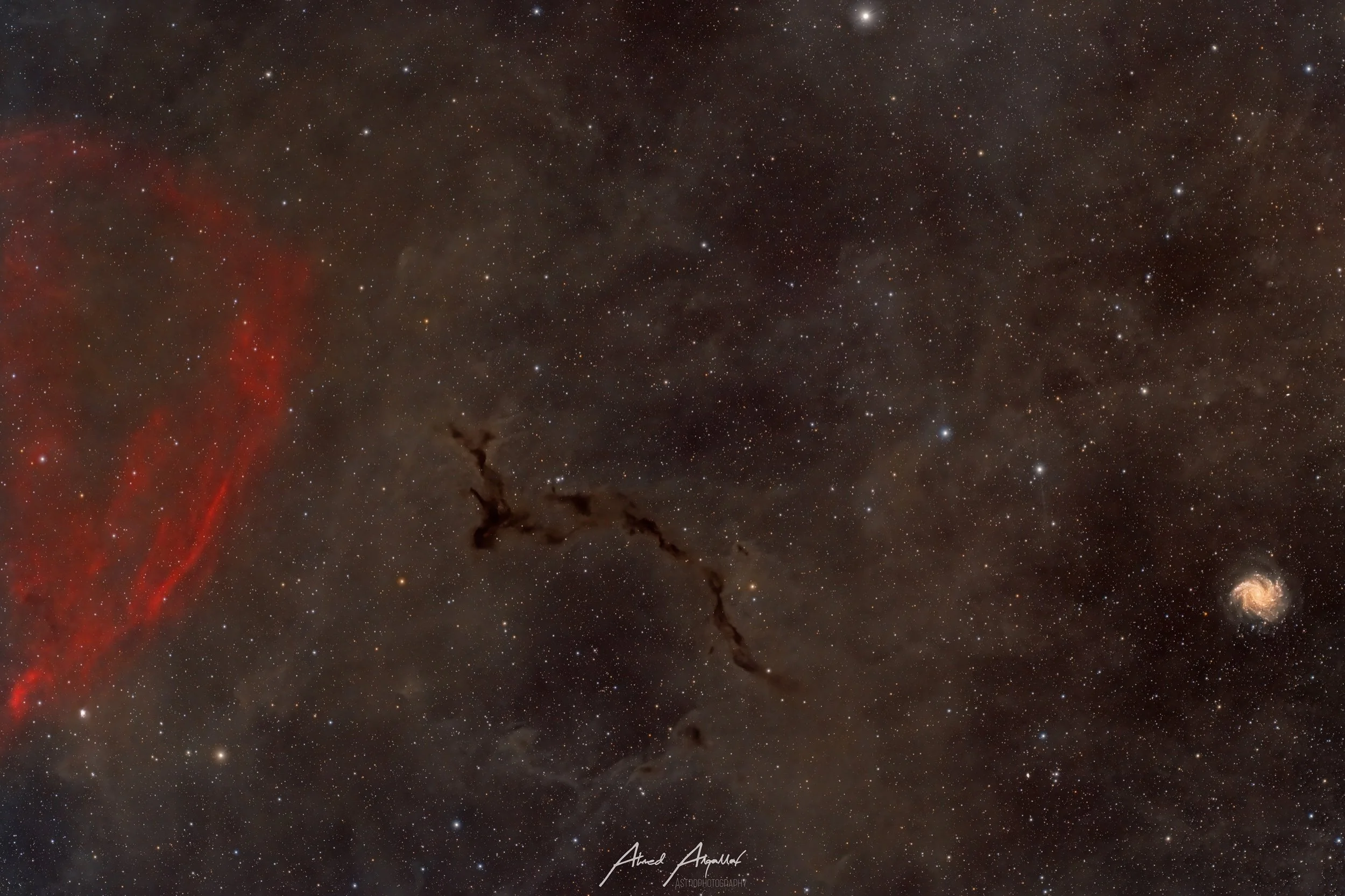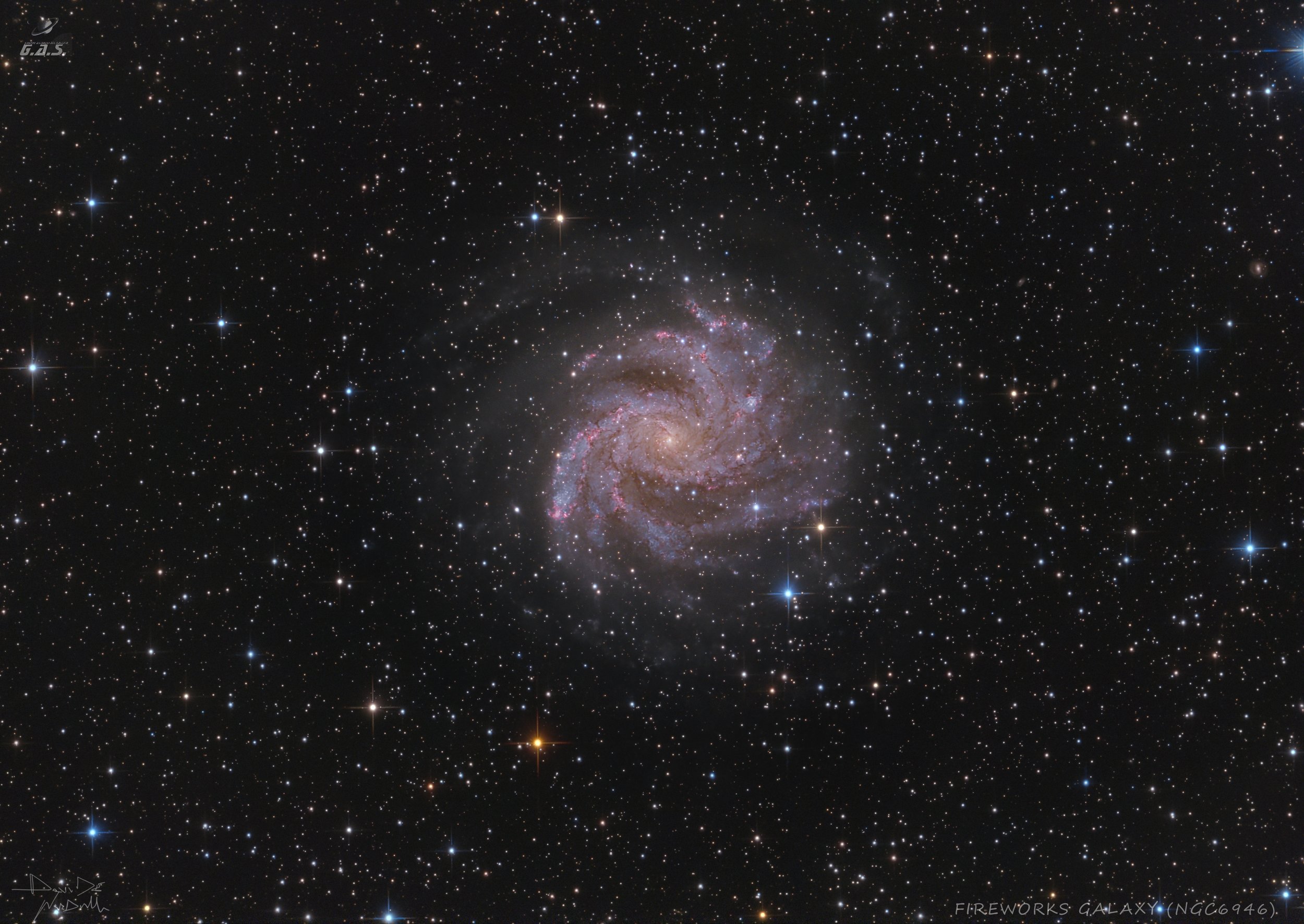
AAPOD2 Image Archives
NGC 7822
Image Description and Details: Can you see the face in space ? Blue eyes, a dark nose and mouth with curly red hair….
The red in space is ionised hydrogen and blue is atomised oxygen. Cosmic pillars of cold molecular gas and clouds of dark dust – often called elephant trunks – lie within NGC 7822. Powering the nebular glow are the young, hot stars of the Berkeley 59 cluster, whose powerful winds and radiation also sculpt and erode the dense pillar shapes. Stars could still be forming inside the pillars by gravitational collapse, but as the pillars are eroded away, any forming stars will ultimately be cut off from their reservoir of star stuff…..
Solar Eclipse from Texas
Image Description and Details: It was a great experience to enjoy this great phenomenon of nature, although from where I was (Dallas, Tx.) it was not possible to see 100% of this annular solar eclipse, but here I leave you the result of these images taken from my dedicated telescope I hope you like it, and we will wait for the next total eclipse, from Dallas, now we will see it completely in this area, next April 2024.
WR-134
Image Description and Details: WR 134 est une étoile variable située à environ 6 000 années-lumière de la Terre dans la constellation du Cygne. WR 134 expulse une partie de ces couches externes qui sont ensuite soufflées par le rayonnement intense et les vents stellaires rapides de l’étoile. L’éjecta est ensuite entré en collision avec la nébuleuse ambiante entourant l’étoile pour former cette espèce de disque (en bleu dans l’image).
The Nose of the Elephant Trunk
Image Description and Details: This is the cometary globule inside IC1396, in Cepheus. It is named "the elephant trunk" due to the similarity with the trunk of this big animal. The globule contains many different protostars and it is shaped by a very energetic star in the center of the nebula complex. In this image I composed 3 different sessions: SHO and L-Extreme images taken with my C11HD from my backyard and RGB images taken with CDK500 from Skygems remote service.
M 2-55 and its elusive fragmented bow-shock front
Image Description and Details: M 2-55 is an evolved rarely-imaged planetary nebula in the constellation Cepheus. It was first discovered and identified by the German-American astronomer Rudolph Minkowski on photographic plates at Mount Wilson in 1947. The plates were taken by W.C. Miller with a 10" f/5.2 refractor.
IM 2-55 possesses two sets of bipolar lobes.
It was only in 2020 that a team of Chinese professional astronomers detected an arc of material running from the SE to the SSW. (Chih-Hao Hsia et. al, March 13th 2020, “Discovery of Extended Structures around Two Evolved Planetary Nebulae M 2-55 and Abell 2”). They concluded that this arc was furnishing strong evidence for an interaction of the expanding nebula of \m 2-55 with its surrounding interstellar material. The presence of fragmentation in the arc may be the result of a phenomenon known as Rayleigh-Taylor (RT) instabilities.
A total of 115 hours HaOIIIRGB image capture
The Little Rosette Nebula
Image Description and Details : Little Rosette Nebula or the "Question Mark Point", 4 nights of captures from the "Anysllum" observatory with my colleague Xavi Bros.
Astronomik 6nm Ha: 9h 50'
Astronomik 6nm OIII: 6h 50'
Astronomik 6nm SII: 1h 20'
Total: 18h
Equipment Details: - Orion Optics 14"
- Losmandy Titan
- ZWO ASI2600MM Pro
Copyright: Jaume Zapata & Xavi Bros
Seahorse nebula (Barnard 150)
Image Description and Details : Location:
Al Salmi desert, Kuwait (Bortle 5).
Acquisition
L 62 x 300” (5hr 10min)
R 20 x 300” (1hr 40min)
G 20 x 300” (1hr 40min)
B 20 x 300” (1hr 40min)
Ha 14 x 300” (1hr 10min)
Total integration time 11hr 20min
Gears:
C: ASI294MM Pro
M: AM5
T: RC51
F: ZWO
Copyright: Ahmed Alqallaf
Prominences
Image Description and Details : In a single day, more than 6 large prominences, solar cycle number 25 continues to give us a fabulous spectacle, under 110 degrees Fahrenheit, this work took more than 6 hours, just to be capturing data, of our beautiful sun, plus the hours of image processing. from Dallas, Texas.
Equipment Details: Lunt 100mm,Lunt 60mm
Copyright: Arturo Buenrostro
NGC 7129
IMAGE DESCRIPTION AND DETAILS :
NGC 7129 is a celestial object visible during summer nights in the northern hemisphere (circumpolar visible) in the central-western part of the Cepheus constellation, approximately 4 degrees away from the brightest star of the constellation, Alderamin (magnitude 2.4), in the northeast direction.
NGC 7129 is a reflection nebula located about 3,100 light-years away from Earth. Unlike emission nebulae that emit their own light due to ionization of gas, reflection nebulae do not emit light themselves. Instead, they shine by reflecting the light of nearby stars, typically young and hot stars, that are embedded within or close to the nebula. The light from these stars gets scattered and diffused by dust and gas particles in the nebula, creating a beautiful glow and giving the nebula its characteristic blue color.
NGC 7129 is associated with a young open star cluster, containing young, hot, and massive stars that formed relatively recently from the same molecular cloud of gas and dust.
Reflection nebulae like NGC 7129 typically show characteristic emission spectra with prominent spectral lines of ionized hydrogen (H-alpha) and other elements. The H-alpha line is often observed in red light due to the ionized hydrogen gas.
The dust grains within the reflection nebula can cause interstellar extinction, meaning they absorb and scatter light from background stars, making them appear fainter and redder.
NGC 7129 represents the remnants of a just hatched cocoon of O and B spectral class stars, making it a nursery of sorts. The recently born, young, and powerful stars, estimated to be a few hundred thousand years old, particularly the O-class stars, are among the hottest and most luminous in the universe. Their surface temperatures are significantly higher, exceeding 30,000 degrees Celsius, approximately six times hotter than our star (which shines with yellow light at about 5,600 degrees Celsius). This high temperature makes the O-class stars very bright and contributes to their bluish color.
Currently, their powerful stellar winds are sweeping away the remnants of their cocoons, which, when ionized, give the reflection nebula its visible color spectrum in the image.
Class O stars are stars with a fleeting life, quite different from our own. Due to their mass and high rate of nuclear fuel consumption, they have a short lifespan compared to other classes of stars, quickly (in astronomical terms) depleting their nuclear fuel and ending their existence as brilliant supernovae.
These stars are characterized by the presence of very strong spectral lines of ionized neutral hydrogen (known as H-alpha lines) and other lines of elements such as helium and nitrogen. The presence of these characteristic spectral lines helps astronomers identify and classify O-class stars.
SETUP:
Omegon Pro RC 304/2432 Truss
iOptron CEM120
ZWO ASI2600MM Pro
Acquisition Details:
Optolong Blue 2": 38×300,″(3h 10′)
Optolong Green 2": 38×300,″(3h 10′)
Optolong H-Alpha 3nm 2": 60×600,″(10h)
Optolong Luminance 2": 135×600,″(22h 30′)
Optolong Red 2": 38×300,″(3h 10′) (gain: 100.00)
COPYRIGHT:
DeepLab
ldn673
IMAGE DESCRIPTION AND DETAILS :
Captured at PixelSkies, Castillejar, Spain
Drizzle x2
Lum 100 x 300s
Red 100 x 300s
Green 99x 300s
Blue 97x 300s
33 hours total.
Equipment used:
Telescope: Takahashi Baby Q FSQ-85ED F3.9
Camera: Xpress Trius SX-694 Pro Mono Cooled to -20C
Image Scale: 2.8
Guiding: OAG
Filters: Astronomik Lum,Red,Green,Blue
Mount: iOptron CEM60 "Standard" GOTO Centre Balanced Equatorial Mount
Image Acquisition: Voyager
Observatory control: Lunatico Dragonfly
Stacking and Calibrating: Pixinsight
Processing: Pixinsight 1.8, Photoshop CC, StarXTerminator, StarNet v2, NoiseXTerminator, BlurXTerminator
COPYRIGHT:
David Wills
LDN 1262
IMAGE DESCRIPTION AND DETAILS :
LDN 1262 is a molecular cloud in the constellation Cepheus and about 1000 light years away. It is located near the better known LDN 1251 "Rottenfish Nebula".
Imaging date: 25 and 26 July 2023
Exposure time: LRGB 330′:105:120′:80′ =10h35m
Telescope: 10″f4 ONTC Newtonian
Focal length: 1000mm
Camera/filter: Touptek ATR3CMOS26000KMA with Baader LRGB
Mount: ASA DDM60 Pro
Conditions / SQM: Moon was already slightly interfering and causing gradients especially in the red channel.
Location: Valdín/Spain
COPYRIGHT:
Thomas Bähnck
Ngc6744
NGC 6744 is an intermediate spiral galaxy about 30 million light-years away in the constellation Pavo. With its flocculent arms and elongated core it is considered to be a much larger (200,000 light year span) Milky Way analogue. Like the Milky Way the bright central region has a dense number of bright old yellow stars, with numerous star forming regions in the arms.
Imaged in LRGB on our Planewave CDK 1000 at Observatorio El Sauce, Chile.
Outer frame field of view extension data RiDK 700
Image acquisition and processing: Mike Selby
Deep clouds of Andromeda
IMAGE DESCRIPTION AND DETAILS :
Telescope: Nikon 400mm f/2.8 @f/4 (Andromeda Galaxy) - Canon 200mm f/2.8 (Ha)
Camera: CCD FLI Microline KAI 11002 (Andromeda Galaxy) and CMOS QHY 268m (Ha)
Filters: Astrodon I series LRGB - Astrodon Ha
Mount: 10 micron GM2000 HPS II
Processing: PixInsight
Exposure: L 26,5h - RGB 18h - Ha 55,5h
From Lanciano (Itay)
COPYRIGHT:
Antonio Ferretti & Attilio Bruzzone
M94
IMAGE DESCRIPTION AND DETAILS :
An LRGB Composition of Messier 94. Messier 94 (also known as NGC 4736) is a spiral galaxy in the mid-northern constellation Canes Venatici. It was discovered by Pierre Méchain in 1781 and catalogued by Charles Messier two days later. Although some references describe M94 as a barred spiral galaxy, the "bar" structure appears to be more oval-shaped. It is classified as having a low ionization nuclear emission region (LINER) nucleus. LINERs in general are characterized by optical spectra that reveal that ionised gas is present but the gas is only weakly ionized (i.e. the atoms are missing relatively few electrons).
The galaxy has two ring structures - the inner ring with a diameter of about 5,400 light-years and an outer ring with a diameter of about 45,000 light-years. These rings appear to form at resonance points in the disk of the galaxy. The inner ring is the site of strong star formation activity and is sometimes referred to as a starburst ring. This star formation is fuelled by gas driven dynamically into the ring by the inner oval-shaped bar-like structure.
Image details:
- Optics: Officina Stellare ProRC 700.
- Camera: FLI PL16803 CCD.
- Filters: Astrodon LRGB.
- Location: IC Astronomy Observatory, Spain.
- Exposure: 9h20m.
- Acquisition: Image data acquired remotely using the Telescope Live SPA-2 telescope.
- Processing: PixInsight & Adobe Photoshop.
Copyright: Chris Willocks.
An Enormous 100,000km Solar Prominence
Image details:
On Saturday, June 17, at 12:44 pm (UTC-3), I had the incredible opportunity to capture a massive yet delicate solar prominence situated on the northwest limb of the sun. This extraordinary plasma formation soared to an impressive height of approximately 100,000 km, with a width spanning over 150,000 km. Although its appearance was brief, its grandeur left a lasting impression.
Within the solar disk, my observation revealed the presence of 8 active regions, each adorned with sunspots of varying sizes. Additionally, captivating prominences surrounded the sun, showcasing their captivating structures.
The art of solar observation and photography constantly holds surprises, and this event was truly breathtaking. Such a magnificent prominence serves as a reminder of the awe-inspiring phenomenon our sun can exhibit!
To capture this sight, I used a 90mm aperture Coronado SolarMax II telescope, paired with a Player One Saturn-M SQR camera.
COPYRIGHT:
Eduardo Schaberger Poupeau
Dark Molecular Clouds in Cepheus
IMAGE DESCRIPTION AND DETAILS :
LRGB IMAGE CAPTURED AND PROCESSED BY JOSÉ GARCÍA AND FRANCISCO SERRANO
In this image we can see a dusty area in the constellation of Cepheus, the diffuse molecular clouds are catalogued as LBN 550, LBN 552 and LBN 555 and LDN 1228.
GN 21.00.4, also known as Cohen 129 or RNO 129 is a small yellowish reflection nebula and compact star forming group in the much bigger dust cloud LBN 552.
It was captured between José García and Francisco Serrano, in several sessions on July of 2023 in a 2.6 sky bortle, on Moratalla, Spain.
Technical data:
- Constellation of Cepheus
- Fotografía: SkyWatcher EQ6R PRO. Esprit ED 80 PRO SkyWatcher. ZWO ASI 294MM- Astrodon LRGB 1,25
SkyWatcher HEQ5 PRO. WO GT81. ZWO ASI 294MM- Astronomik L-2 36mm
- Guiado: Zwo Asi 120MM. Svbony SV165
Zwo Asi 120MM mini. WO Uniguide 50mm
- Lights:
169x120sg (Astrodon Gen2 L) + Tomas de calibración
240x120sg (Astrodon Gen2 RGB) + Tomas de calibración
154x120sg (Astronomik L-2) + Tomas de calibración
- Total integration: 18h 46min
COPYRIGHT:
José García & Francisco Serrano
The Tulip Nebula (SH2-101): A Celestial Garden of Stellar Beauty
IMAGE DESCRIPTION AND DETAILS :
The Tulip Nebula (SH2-101) is an awe-inspiring H II region emission nebula situated in the Cygnus constellation. Named for its striking resemblance to a delicate tulip flower, this celestial wonder radiates with vibrant colors and showcases intricate tendrils of glowing gas and dust. Located approximately 6,000 light-years away from Earth, it serves as a captivating cosmic nursery, where new stars are born amidst a breathtaking display of stellar beauty and celestial artistry.
Astrobin : https://www.astrobin.com/j2mpzi/
Sky-Watcher Esprit 80ED
ZWO ASI533MC Pro
Sky-Watcher EQ6-R Pro
Optolong L-Ultimate 1.25"
ZWO EAF · ZWO Filter Drawer (M42) · ZWO OAG (Off-Axis Guider)
Software
Adobe Photoshop · Pleiades Astrophoto PixInsight · Stefan Berg Nighttime Imaging 'N' Astronomy (N.I.N.A. / NINA)
Guiding Cameras
ZWO ASI120MM Mini
Acquisition details
Dates: July 4, 2023
Frames:
Optolong L-Ultimate 1.25": 354×300″(29h 30′) (gain: 100.00) f/5 0°C bin 1×1
Integration: 29h 30′
Darks: 50
Flats: 40
Flat darks: 40
Avg. Moon age: 15.94 days
Avg. Moon phase: 98.44%
Temperature: 35.00
Orientation: 63.841 degrees
Field radius: 0.888 degrees
Locations: Tunis, Tunis, Tunis, Tunisia
Data source: Backyard
COPYRIGHT:
Makrem Larnaout
NGC6946 - Fireworks Galaxy
Image Description and Details :
NGC6946 - Fireworks Galaxy - Constellation Cepheus
NGC 6946 is located in the constellation Cepheus, bordering that of Cygnus. NGC 6946 is a spiral galaxy about 22 million light years away from us. Numerous supernovae have been observed in it, so much so that it is christened the "fireworks galaxy". It is an intermediate galaxy between spiral and barred spiral galaxies with a high level of star formation. It is believed to be a very active galaxy not only due to the presence of numerous nebulae, incubators of stars but also due to the presence of rivers of hydrogen (cold streams) which allow hydrogen to be distributed in such a way as to maintain the formation of new stars . It differs from our Milky Way precisely because of the greater star formation. It was discovered in 1798 by William Herschel, known for having, among other things (he is credited with identifying Uranus), discovered infrared rays.
Shooting taken in the night between 14 and 15 July 2023 at Palazzo S. Spirito - Stigliano (Mt) Italy , sky quality Bortle 4 sqm 21,20
Technical data and tools
Light: 65 x 300 sec.
Dark: 15
Flat: 15
Dark of the Flats: 15
Filter : Svbony UV-IR cut 2"
Telescope: Ritchey-Chrétien 8" Carbon (203/1624)
Main camera: Zwo Asi 294 mc pro
Camera Guide: Zwo Asi 290 MM mini
Fitment: Skywatcher EQ6-R Pro
Data acquisition and guidance : Zwo Asiair Pro
Software: PixInsight - Photoshop
Copyright: Davide Nardulli
NGC7497
This is an image of NGC 7497. It is an edge-on spiral galaxy about 60 million light years away in the constellation Pegasus. The nebula surrounding the galaxy is known as MBM 54 and is located about 1,000 light years away in the outer regions of our galaxy. These types of molecular clouds are found at high galactic latitudes (parts of the sky away from the plane of our Milky Way Galaxy). They are often referred to as galactic cirrus clouds or more commonly "Integrated Flux Nebulae" (IFN).
Image Data: Telescope Live
July 18, 2023
Location: Rio Hurtado, Chile
Telescope: Planewave CDK-24
Camera: QHY 600M Pro
Mount: Mathis MI-1000/1250
Luminance: 32x5 minutes (binned 2x2)
Red: 32x5 minutes (binned 2x2)
Green: 35x5 minutes (binned 2x2)
Blue: 32x5 minutes (binned 2x2)
Copyright: Bernard Miller
Patchick 4
Image Description and Details :
Patchick 4
A planetary nebula in Cygnus discovered by my good friend Dana Patchick in 2005.
It is 8 arc minutes in diameter.
Another joint project with Sven Eklund using our remote telescopes in Spain.
Scopes: APM TMB LZOS 152 Refractors and Celestron C14 Edge HD
Cameras: QSI6120wsg8 and ZWO ASI6200MM Pro
Mounts: 10Micron GM2000 HPS and 10Micron GM3000 HPS
A total of 43 hours 15 minutes (HaOIIIRGB)
Copyright: Peter Goodhew, Sven Eklund





















